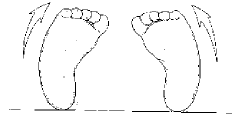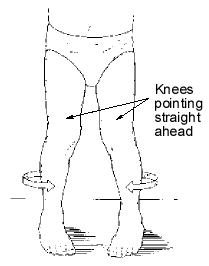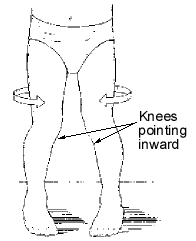Dr. MJ Bazos MD,
Patient Handout
Intoeing
What is intoeing?
Most people's feet point straight ahead or
outward. In some people, however, the feet point inward. This is called intoeing
(say "in-toe-ing"), or "pigeon toes." Intoeing is very common in young children.
Most of the time, intoeing goes away without any treatment at all. In a few
children, it doesn't get better on its own and must be treated.
Is intoeing serious?
Intoeing usually doesn't cause serious problems,
even if it doesn't go away by itself. Intoeing doesn't cause arthritis or
clumsiness. Sometimes children with intoeing have problems getting shoes that
fit, because of the curve of their feet. This fitting problem might make parents
consider treatment for their child. Most braces, shoe inserts and special shoes
are expensive and don't fix the problem.
A very few children have a severe twist in the
leg bone (tibia) or thigh bone (femur), which might bother them because it looks
bad. Sometimes this problem requires surgery.
What causes intoeing?
There are three causes of intoeing in healthy
children. They are metatarsus adductus, internal tibial torsion and excessive
femoral anteversion.
What is metatarsus adductus?
Metatarsus adductus is a curve in the foot. This
is best seen if you look at the sole of your child's foot, shown in the
accompanying drawing. If your child has metatarsus adductus, you may notice it
while he or she is still a baby. The curve in the foot is probably caused before
the baby is born, when the feet are pressed into this position inside the
uterus. In 9 out of 10 children with this problem, the feet get straight as the
children grow up.
Your doctor may show you how to stretch the
baby's foot to help the foot get straighter. If the foot shape is very curved or
the curve doesn't go away, your doctor may treat your baby by putting casts on
the feet to help stretch them into a straight position.
Doctors have different ideas about when the
casts should be put on, but many think that if the feet are still curved when
the child is 4 to 6 months old, casting should be started. The casting should be
finished before the child reaches normal walking age. If the feet still have
some curve after the casting treatment, that will not cause any problems with
running and playing, and is never painful. A strong curve can cause problems
with fitting shoes, and this is the main reason for using
casts.
What is internal tibial torsion?
Internal tibial torsion is a twist in the tibia
(the leg bone between the knee and the ankle) as shown in the accompanying
drawing. Parents usually notice internal tibial torsion about the time their
child begins to walk. Some inward twist of the tibial bone is normal in babies.
Usually this twist straightens out during the baby's first year. In some
children, the twist doesn't get straight enough that their feet point straight
ahead or outward, and these are the children who still intoe when they begin
walking. Leg bones usually continue to grow straighter until the child is 6 to 8
years old.
Braces and special shoes are not very helpful.
One treatment that has been used is a bar with shoes on it that makes the
child's feet point out. It hasn't been shown to work. Braces like this one are
expensive, and often children don't like to wear them. So most doctors don't
give any treatment for internal tibial torsion in young children. In a small
number of children, the twist in the tibia doesn't go away. Even if the twist
remains, it hasn't been shown to cause arthritis or problems with running and
jumping.
Sometimes appearance is a problem. In this case,
the treatment is to cut the bones and turn (rotate) the bones outward, so the
feet point straight. Very few children have to have this surgery. This is
something that must be carefully discussed with your child's doctor.
What is excess femoral anteversion?
|
|
|
Excess femoral
anteversion
|
Excessive femoral anteversion is an inward twist
in the femur (thigh bone), as shown in the accompanying drawing. This cause of
intoeing usually shows up in children between the ages of 2 and 4. It can get
worse during early childhood.
All babies are born with some inward twist of
the thigh bone. It usually gets better during the first years of life. In babies
and toddlers, the ligaments and muscles that connect the bones are tight. As
children begin walking, these ligaments and muscles become looser, allowing the
hips to rotate more inward. If a child has an extra inward twist of the thigh
bone, it may not show up until the child is 2 to 4 years old, because the
intoeing gets worse as the ligaments and muscles become looser.
Excess femoral anteversion usually gets better
by itself. In most children, the feet will point straight ahead or outward by
the time they are 6 to 8 years old. Braces or shoe modifications won't help. In
a few children with a very strong inward twist in the thigh bone, an operation
is possible, to cut this bone and twist it outward, so the feet will point
straight ahead.



